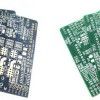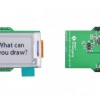PCB Surface Finish Explanation and Comparison
HASL, OSP, ENIG Explained and Compared
Having trouble deciding which surface finish to use? You aren’t alone!
Surface finishes serve a two-fold purpose. One is to ensure solderability and the other to protect the conductibility of the surface against oxidation and corrosion.
There is no “x is best” for PCB surface finishes. Each finish comes with its own trade-offs that you’ll have to weigh. Which surface finish you choose will ultimately come down to the design of the PCB, the assembly of its components, and it’s end application/environment.
Questions to ask yourself before deciding:
How important is pad flatness for assembly?
How reliable do the solder joints need to be/solderability?
Does it need to be RoHS compliant?
Is cost important?
How long is the minimum shelf life?
HASL (Hot Air Solder Leveling)
HASL is by far the most common surface finish used the industry. It’s an inexpensive option that is frequently used in boards that don’t need to be RoHS compliant, especially in boards meant for prototyping or personal use. As an industry default, manufacturers have a high familiarity with the application process and are less prone to error.
Another benefit is the excellent solderability that this finish creates for the plating and IC components. It’s applied by first getting immersed in a tin/lead alloy. Then, hot air is blown across the surface ‘cutting off’ excess solder, hence it’s unabbreviated name: Hot Air Solder Leveling. If you need a finish that has good shelf-life, this may be the surface finish for you. Its solderability can also withstand multiple manufacturing processes such as reflowing and washing.
However, this application process yields topographical differences between plates which can cause assembly issues and is not aesthetically pleasing. Therefore, it is not ideal for HDI (high density interconnect) PCBs or those with fine pitching, particularly <20mil between BGA and SMD.
HASL Lead-Free
Lead-free HASL not only keeps the benefits of leaded HASL, but also has additional benefits. Namely, that it is lead-free and therefore RoHS compliant. This is necessary if you do business in the EU and California. And by utilizing copper, nickel, tin, cobalt, or silver solder alloys, copper dissolution and heat damage issues have mostly been overcome.
While slightly more expensive then leaded HASL finish, among the lead-free finishes lead-free HASL is relatively inexpensive. However, since the application process is similar to HASL, it is also not recommended for those PCBs that contain small distances between BGA and SMTs. During heating, the gap between components is frequently bridged. High temperatures are also required to melt lead-free solder, so it might be bothersome to DIYer’s who don’t have the proper equipment.
Again, the main selling point of lead-free HASL is its relatively inexpensive cost and its exceptional solderability.
OSP (Organic Solderability Preservative)
Where Lead-Free HASL loses on PCBs with fine pitches, as lead-free and organic, OSP is an excellent choice for an inexpensive, environmentally friendly surface finish for your fine pitches. This surface finish even beats other lead-free solutions which still use toxic materials in their processes or consume more energy to apply.
As you might guess from P standing for preservative, OSP preserves the copper surfaces of plates from oxidation by way of a very thin protective layer of material. After a cleaning process, a water based compound selectively bonds to the copper and then protects the copper pad before soldering. However, the downside of this finish material is that the oxidation protection is not absolute. Careful handling of the boards is necessary during assembly as acid from fingerprints may cause oxidation anyway. It also does not allow wave soldering for double-sided boards because the thermal exposure might also cause oxidation of the copper. Oxidation will reduce the solderability of the copper.
Although it can be difficult to test, as previously mentioned, it is very well suited for fine pitches, BGA, and small components as the topography of the coating is very flat. It also doesn’t demand high equipment maintenance and is highly repairable.
ENIG (Electroless Nickel Immersion Gold)
ENIG is the best lead-free solution for PCBs (it’s also an expensive one). An excellent option for fine pitches and flat surfaces; it suits the modern-day PCB design trend of HDI and tight pitches between BGAs and SMTs.
It’s composed of a double layer of metallic coating. Nickel acts as a barrier to copper and a surface for SMT placement and a thin layer of gold protects the nickel from oxidation. A couple downsides arise from the metallic composition however, one being undesirable magnetic properties and the other is known as “black pad” where a buildup of phosphorous between the layers causes faulty connections and fractured surfaces.
Although a more complex and pricey process, thanks to the rise of RoHS compliance and environmental consciousness, ENIG is perhaps the fastest growing trends in the industry. Although it cannot be easily reworked, its excellent planarity matches the needs of technological advances.
| HASL | HASL Pb Free | OSP | ENIG | |
|---|---|---|---|---|
RoHS Compliant | No | Yes | Yes | Yes |
| Flatness | Poor | Poor | Excellent | Excellent |
| Fine Pitch/SMT/BGA | No | No | Yes | Yes |
| Solderability | Best | Better | Good | Good |
| Shelf-Life | >1 year | >1 year | 9-12 Months | >1 year |
| Cost | Low | Low | Low | Medium |
This surface finish list is by no means exhaustive, but these are the relatively more common types used in manufacturing. Ultimately, you will need to weigh the trade-offs against the PCB’s purpose to choose a surface finish. You can see for yourself the price difference between the four surface finishes discussed above on our online quotation page.




